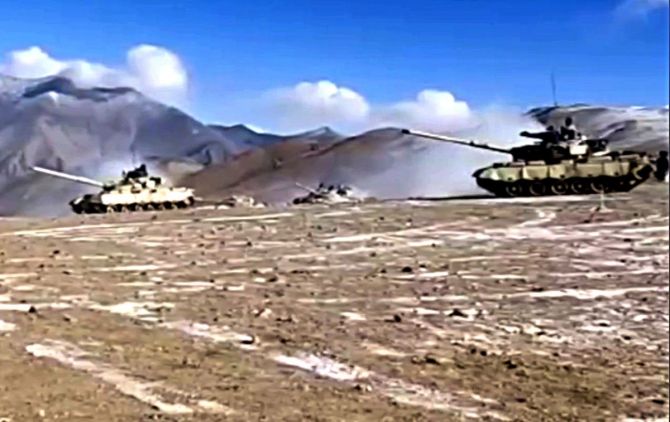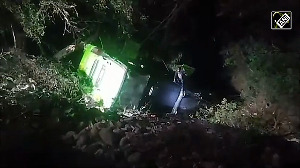Once the tanks roll back, a zero-based assessment of future equations with China is necessary.
Given the conflict situations that China is imposing on India time and again, the red, amber and green lines of interactions with China need to be laid down and communicated in no uncertain terms, asserts Srikanth Kondapalli, the leading China expert.

The dramatic climb down announcement by China's ministry of national defense spokesperson Senior Colonel (Brigadier rank) Wang Qian on 'synchronised disengagement' in the Pangong Tso area of the western sector of the border with India and the quick statement by Defence Minister Rajnath Singh in Parliament on no loss of territory by India provides for potential new beginnings in the bilateral relations as well as for the Asian landscape.
First, once both the frontline troops and military equipment like tanks and armoured personnel carriers withdraw up to east of Finger 8 (at Sirijap) by the Chinese troops and the Indian troops till Finger 3 of the contentious Pangong Tso lake area after a 'phased, coordinated and verifiable' procedure, other 'friction points' where for the past over 250 days tensions have simmered will be addressed for an eventual restoration of the peace and stability across the imaginary Line of Actual Control as it existed early last year.
This is a tall claim and involved complicated -- and certainly nerve wracking -- mutual verification processes at the ground level.
A similar exercise on June 15 last year -- initiated after the local corps commanders meeting of both sides -- led to the killing of 20 Indian soldiers at Galwan (and 45 Chinese soldiers according to the Russian TASS agency and over 120 by the American reports).
As the past nearly one year's armed stalemate indicated, China's assessment appeared to be that India isn't cowed down. Indeed, Indian conventional deterrence posture and unified political leadership response paid off.
Secondly, while there is a disjuncture between the two leadership's announcement -- one by a senior colonel rank military officer from China and the other by no less than the defence minister of a big and rising country in Asia -- if the agreement is to be followed in toto for disengagement of troops, then we may find gradually both sides intensifying the definition of the LAC, given the current assessments that by conflict this issue cannot be resolved.
Throughout this episode, it is stark that China's strategic level leadership hardly made any significant statements. President Xi Jinping did pep up his troops with 'combat readiness' statement but these were lost in the din.
China's defence minister made no public statement on the issue, although he tried to exert pressure on India by visiting Nepal and Pakistan in vain. Foreign Minister Wang Yi visited Tibet, but made no specific comments on the armed mobilisation against India.
The war of words was left to done by a nationalist tabloid in China with disastrous consequences for Beijing.
In contrast to the visible lack of direction on the part of China, Prime Minister Narendra Damodardas Modi visited Ladakh and interacted with frontline troops. Defence Minister Rajnath Singh visited forward areas across the LAC several times. Foreign Minister Dr Subrahmanyam Jaishankar read out 'red lines' for China in bilateral relations.
Indian Army chief General Manoj Mukund Naravane even made the defiant statement that India will not withdraw from the Kailash ranges after the Special Frontier Force regained control over five hill tops on August 29 last year. The Indian Air Force chief stated of possible retaliation.
China thus had no choice but to blink this time, as during the Dokalam crisis in 2017.
Thirdly, despite concluding several official agreements with India in 1993, 1996, 2005 and 2013 on not altering the status quo and mobilising forces across the LAC, China's stealthy actions since March 2020 smacked of violating the fundamental and universal principles of Just War traditions.
By reviving the rejected 1959 line claim of then premier Zhou Enlai, China further complicated the matter.
Fourthly, unlike in the previous period influenced by the 1962 debacle, when Indian Army soldiers exhibited psychological fear that the Chinese would use any constructed roads to pounce on them, in the current armed stalemate at the western and at Sikkim sectors, living in eye-ball to eye-ball confrontation, mobilising tanks a few metres away or making comprehensive plans for one-upman ship have all elevated the morale of the Indian troops who are now debunking any asymmetry in power relations of China.
Clearly, in this round, the Indian armed forces crossed the Himalayan Rubicon.
Fifthly, as we hit rock bottom in bilateral relations and as the dust settles down once the tanks roll back, a zero-based assessment of future equations with China is necessary.
Given the internecine conflict situations that China is imposing on India time and again, the red, amber and green lines of interactions with China need to be laid down and communicated in no uncertain terms.
This would be the harbinger for a rising India and a direction for many Asian countries in the years to come.
Srikanth Kondapalli is Professor in Chinese Studies at Jawaharlal Nehru University.












 © 2025
© 2025